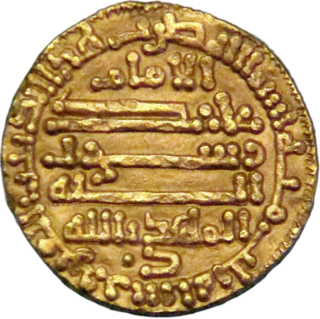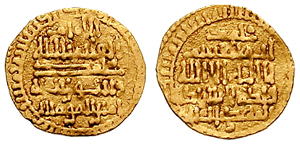Related Research Articles

Year 928 (CMXXVIII) was a leap year starting on Tuesday of the Julian calendar.

The Fatimid dynasty was an Isma'ili Shi'a dynasty of Arab descent that ruled an extensive empire, the Fatimid Caliphate, between 909 and 1171 CE. Claiming descent from Fatima and Ali, they also held the Isma'ili imamate, claiming to be the rightful leaders of the Muslim community. The line of Nizari Isma'ili imams, represented today by the Aga Khans, claims descent from a branch of the Fatimids. The Alavi Bohras, predominantly based in Vadodara (Baroda) also descend from the branch of the Fatimids.

Abū Muḥammad ʿAbd Allāh ibn al-Ḥusayn, 31 July 874 – 4 March 934, better known by his regnal name al-Mahdi Billah, was the founder of the Isma'ili Fatimid Caliphate, the only major Shi'a caliphate in Islamic history, and the eleventh Imam of the Isma'ili branch of Shi'ism.

Abu Tahir Isma'il, better known by his regnal name al-Mansur bi-Nasr Allah, was the third caliph of the Fatimid Caliphate in Ifriqiya, ruling from 946 until his death. He presided over a period of crisis, having to confront the large-scale Kharijite rebellion of Abu Yazid. He succeeded in suppressing the revolt and restoring the stability of the Fatimid regime.

Abū al-Qāsim Muḥammad ibn ʿAbd Allāh, better known by his regnal name al-Qāʾim (القائم) or al-Qāʾim bi-Amr Allāh was the second Caliph of the Fatimid dynasty, ruling in Ifriqiya from 934 to 946. He was the 12th Isma'ili Imam, succeeding his father Abd Allah al-Mahdi Billah.

The navy of the Fatimid Caliphate was one of the most developed early Muslim navies and a major military force in the central and eastern Mediterranean in the 10th–12th centuries. As with the dynasty it served, its history can be distinguished into two phases. The first period, from c. 909 to 969, when the Fatimids were based in Ifriqiya, and the second period, lasting until the end of the dynasty in 1171, when the Fatimids were based in Egypt. During the first period, the navy was employed mainly in the constant warfare with the Byzantine Empire in Sicily and southern Italy, where the Fatimids enjoyed mixed success, as well as in the initially unsuccessful attempts to conquer Egypt from the Abbasids and the brief clashes with the Umayyad Caliphate of Córdoba.

The Battle of the Straits was fought in early 965 between the fleets of the Byzantine Empire and the Fatimid Caliphate in the Straits of Messina. It resulted in a major Fatimid victory, and the final collapse of the attempt of Emperor Nikephoros II Phokas to recover Sicily from the Fatimids.
Al-Hasan ibn Ali ibn Abi al-Husayn al-Kalbi, known in Byzantine sources as Boulchasenes and Aboulchare (Ἀβουλχαρέ), was the first Kalbid Emir of Sicily. A member of an aristocratic family within the ruling circle of the Fatimid Caliphate, he helped suppress the great revolt of Abu Yazid in 943–947 and was sent as governor of Sicily from 948 until 953, when he returned to Ifriqiya. He was succeeded in Sicily by his son Ahmad ibn al-Hasan al-Kalbi, but led several campaigns in Sicily and southern Italy against the Byzantines in 955–958, as well as the raid against Almeria that sparked a brief conflict with the Caliphate of Córdoba in 955. He died at Palermo in 964, during another campaign against the Byzantines.
Jawdhar, surnamed al-Ustadh, was a eunuch slave who served the Fatimid caliphs al-Qa'im, al-Mansur, and al-Mu'izz as chamberlain and de facto chief minister until his death. He was an extremely powerful figure in the Fatimid court, and was ranked immediately after the caliph and his designated heir. The accession of al-Mansur was probably due to Jawdhar's machinations, and he was placed in charge of keeping the new caliph's relatives under house arrest. He enjoyed close relations with the Kalbid emirs of Sicily, which enabled him to engage in profitable commerce with the island. Jawdhar accompanied al-Mu'izz during the migration of the court from Ifriqiya to Egypt, but died on the way at Barqa. His collected documents and letters were published after his death by his secretary as the Sirat al-Ustadh Jawdhar, and form one of the main historical sources for the governance of the Fatimid state in the period.
Ya'qub ibn Ishaq al-Tamimi was a naval commander in Fatimid service who led a major raid against the Italian coasts, Sardinia and Corsica in 934–935.
Al-Ḥasan ibn ʿAmmār al-Kalbī, usually called simply Ibn Ammar in the Arabic sources, was an Arab commander for the Fatimid Caliphate. A member of the Kalbid family, he was active in the wars with the Byzantine Empire in Sicily in the 960s, leading the capture of Taormina and Rometta, which completed the Muslim conquest of Sicily.
The first Fatimid invasion of Egypt occurred in 914–915, soon after the establishment of the Fatimid Caliphate in Ifriqiya in 909. The Fatimids launched an expedition east, against the Abbasid Caliphate, under the Berber General Habasa ibn Yusuf. Habasa succeeded in subduing the cities on the Libyan coast between Ifriqiya and Egypt, and captured Alexandria. The Fatimid heir-apparent, al-Qa'im bi-Amr Allah, then arrived to take over the campaign. Attempts to conquer the Egyptian capital, Fustat, were beaten back by the Abbasid troops in the province. A risky affair even at the outset, the arrival of Abbasid reinforcements from Syria and Iraq under Mu'nis al-Muzaffar doomed the invasion to failure, and al-Qa'im and the remnants of his army abandoned Alexandria and returned to Ifriqiya in May 915. The failure did not prevent the Fatimids from launching another unsuccessful attempt to capture Egypt four years later. It was not until 969 that the Fatimids conquered Egypt and made it the centre of their empire.
The second Fatimid invasion of Egypt occurred in 919–921, following the failure of the first attempt in 914–915. The expedition was again commanded by the Fatimid Caliphate's heir-apparent, al-Qa'im bi-Amr Allah. As during the previous attempt, the Fatimids captured Alexandria with ease. However, while the Abbasid garrison in Fustat was weaker and mutinous due to lack of pay, al-Qa'im did not exploit it for an immediate attack on the city, such as the one that had failed in 914. Instead, in March 920 the Fatimid navy was destroyed by the Abbasid fleet under Thamal al-Dulafi, and Abbasid reinforcements under Mu'nis al-Muzaffar arrived at Fustat. Nevertheless, in the summer of 920 al-Qa'im was able to capture the Fayyum Oasis, and in the spring of 921 extend his control over much of Upper Egypt as well, while Mu'nis avoided an open confrontation and remained at Fustat. During that time, both sides were engaged in a diplomatic and propaganda battle, with the Fatimids' in particular trying to sway the Muslim populace on their side, without success. The Fatimid expedition was condemned to failure when Thamal's fleet took Alexandria in May/June 921; when the Abbasid forces moved on Fayyum, al-Qa'im was forced to abandon it and flee west over the desert.
The Fatimid conquest of Egypt took place in 969, as the troops of the Fatimid Caliphate under the general Jawhar captured Egypt, then ruled by the autonomous Ikhshidid dynasty in the name of the Abbasid Caliphate.
Ahmadibn al-Hasan al-Kalbi was the second Kalbid Emir of Sicily. He was the son of the first Kalbid emir, al-Hasan ibn Ali al-Kalbi, who ruled the island on behalf of the Fatimid Caliphate. Ahmad succeeded his father in May 953 until 968, apart from a brief interruption in 958/9. In the 960s, he led the completion of the Muslim conquest of Sicily by capturing the last Byzantine strongholds of Taormina and Rometta and defeating a Byzantine relief expedition. He was recalled to Ifriqiya to participate in the upcoming Fatimid conquest of Egypt, and died there shortly after.
Ahmad ibn Ziyadat Allah ibn Qurhub, commonly known simply as Ibn Qurhub, ruled Sicily in rebellion against the Fatimid Caliphate, from 913 to 916. He launched raids against the Byzantine Empire in southern Italy and against the shores of Fatimid Ifriqiya, but was deposed and handed over to the Fatimids, who executed him and his followers in July 916.
Al-Hasan ibn Ahmad ibn Abi Khinzir was a Fatimid military commander who served as the first Fatimid governor of Kairouan and of Sicily.
Ali ibn Umar al-Balawi was a short-lived Fatimid governor of Sicily in 912–913.
Salim ibn Asad ibn Abi Rashid was the governor of Sicily for the Fatimid Caliphate for twenty years, from 917 to 937.
Khalil ibn Ishaq al-Tamimi was an Arab military commander, in the service of the Fatimid Caliphate as head of the Arab jund of Ifriqiya. He was active as early as 913. From 937 to 941 he was the governor of Sicily, leading the brutal suppression of a large-scale anti-Fatimid revolt. He was captured and killed in 944, during the anti-Fatimid rebellion of Abu Yazid.